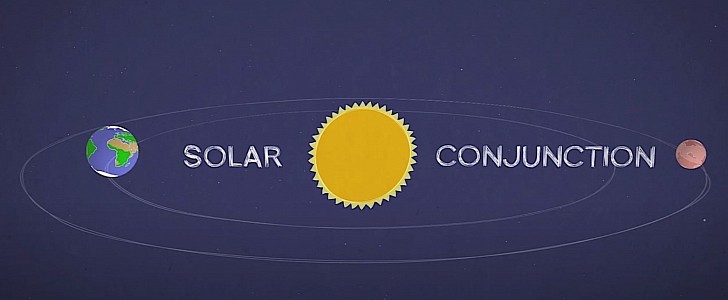By now, pretty much everyone on this piece of floating rock is familiar with the fact that there are human-made machines on Mars. At times, trying to make people understand how they work is pretty difficult for space engineers, and this is why a while back the Jet Propulsion Laboratory decided to create student-grade and simple-to-understand videos of all (important) things related to Mars.
Published over the past few years, these videos (part of a series called Mars in a Minute) are growing increasingly important as we all now try to come to terms with a reality where humanity will begin exploring Mars (and setting up camp on the Moon) sooner than most would have expected.
Given all that, we’ve decided to bring these videos back into focus, and we’ll start with something JPL published back in 2015. Titled “What Happens When the Sun Blocks Our Signal?” and attached below this text, the video tries to shed some light on how engineers on Earth send signals to Mars during solar conjunctions. And the simple answer is… they don’t.
But first things first. As they spin around the Sun, Earth and Mars move closer and further away from each other. Now every two years or so, their orbits take them on opposite sides of the Sun, meaning that the positively huge ball of fire is smackdown between them (that’s a solar conjunction), blocking a direct line of communication between the two planets.
Now, signals could theoretically be sent, but with the Sun in the way, they’d probably be incomplete. For incoming signals, that’s not a big deal, as that’s just data that could be re-sent at a later date.
For outgoing messages, though, that’s a big no-no, as pretty much everything we send from here are instructions on what the hardware on Mars needs to do next. And an incomplete message could significantly damage the hardware, by sending it, for instance, to dive off a cliff.
For the duration of the solar conjunction, which usually lasts a few weeks, the rovers perform the tasks they’d been programmed to perform, while engineers here on Earth, well, they can pretty much do whatever they like.
Given all that, we’ve decided to bring these videos back into focus, and we’ll start with something JPL published back in 2015. Titled “What Happens When the Sun Blocks Our Signal?” and attached below this text, the video tries to shed some light on how engineers on Earth send signals to Mars during solar conjunctions. And the simple answer is… they don’t.
But first things first. As they spin around the Sun, Earth and Mars move closer and further away from each other. Now every two years or so, their orbits take them on opposite sides of the Sun, meaning that the positively huge ball of fire is smackdown between them (that’s a solar conjunction), blocking a direct line of communication between the two planets.
Now, signals could theoretically be sent, but with the Sun in the way, they’d probably be incomplete. For incoming signals, that’s not a big deal, as that’s just data that could be re-sent at a later date.
For outgoing messages, though, that’s a big no-no, as pretty much everything we send from here are instructions on what the hardware on Mars needs to do next. And an incomplete message could significantly damage the hardware, by sending it, for instance, to dive off a cliff.
For the duration of the solar conjunction, which usually lasts a few weeks, the rovers perform the tasks they’d been programmed to perform, while engineers here on Earth, well, they can pretty much do whatever they like.









